4.6.5. Mechanics of BFM
This section will examine the three basic principles of BFM: roll, turn, and acceleration.
4.6.5.1. Roll
Roll allows the pilot to position his lift vector, thus determining the plane of motion in which he will turn. At high speed and low AOA, the F-16 has a very high roll-rate capability. However, as the airspeed slows and AOA builds, the roll performance begins to degrade. At slow speed, in order to roll more rapidly, the AOA must be reduced prior to initiating the roll. It should also be noted that the slower the airspeed, the longer it will take to command a reduction of AOA. This factor becomes very important in slow speed lift vector positioning such as might be required to defeat a gunshot.
An important aspect of roll is the ability to slow the forward velocity of the aircraft. If G is maintained and a roll is initiated, a spiral is made in the flight path, thereby increasing the "through the air" distance the aircraft flies to arrive at any selected point.
An additional benefit of roll is the ability to position the bandit so the pilot can maintain a tally. This is especially useful with an aft quadrant bandit where a simple roll to maintain line of sight (LOS) is preferable to energy depleting "kickouts."
4.6.5.2. Turn
Turn radius determines the size of the turn circle. This radius is based on the aircraft's TAS and radial G. The size of the circle and the relative turn rate capability of the two aircraft will determine how well the pilot can solve the angular problems the defender presents. The objective is to work to where available G will allow the attacker to point his nose at the defender to achieve a missile or gun shot with an acceptable specific power (P) bleed-off. How well an aircraft can turn is a function of the turn rate and s radius it generates.
Radius defines the size of an aircraft's turn or its turning "circle." In the F-16, turn radius at max AOA/G is relatively constant over an airspeed range of 170 knots calibrated airspeed (KCAS) up to 330 KCAS. Above 330 KCAS, turn radius increases slightly as max G is obtained (440 KCAS). Above 440 KCAS, turn radius increases dramatically. Because of the F-16 flight control system, the F-16 does not have a true corner velocity. It has a "corner plateau" which is an airspeed range of 330 - 440 KCAS that produces a good turn rate based on available G. (see Figure 4.9). Offensively, sustained operations are not possible in the same plane against a defender with a smaller turn circle (radius) assuming similar turn rates without inviting an overshoot/reversal situation (Figure 4.10).
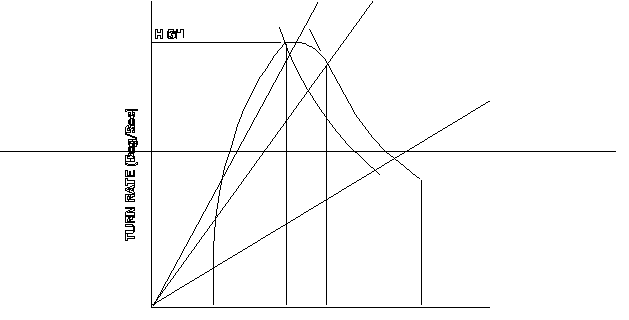
![]()
![]()
Figure 4.9 Turn Rate and Velocity

![]()
Figure 4.10 Overshoot/Reversal Situation
Even if the attacker has the identical turn rate/radius capability as the defender (1v1 similar), the attacker is unable to sustain operations in the same plane to the degree the center of the two turn circles are offset. In a gross example, if the attacker is outside the defender's turn circle and immediately turns, instead of accelerating into the defender's turn circle, roles will be reversed after 180 ° of turn (Figure 4.11).
![]()
![]()
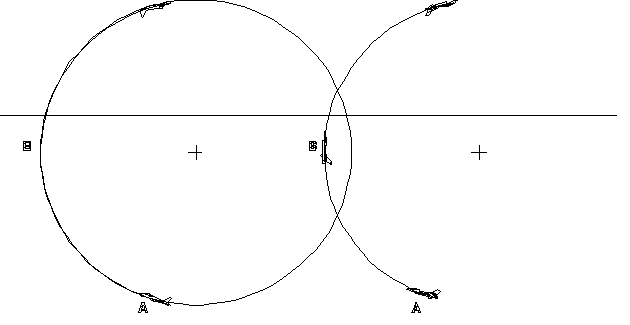
Figure 4.11 Turning on Offset Turn Circles
The attacker's solution to the situation described above (outside defender's turn circle) is to maneuver into the defender's turn circle, aiming toward an "entry window" (Figure 4.12). This involves initially pointing to lag. For example, at point B in Figure 4.12 the attacker has just entered the turn circle and has his nose in lag. Upon reaching the "entry window," to close on the defender the attacker may need an out-of-plane maneuver (discussed later) to avoid overshooting, fo llowed by a pull back towards lead pursuit. The ability to enter the defender's turn circle and control geometric closure by initially pointing to lag is an important concept in BFM.
A defender wants to decrease his turning circle as much as possible. This is because a superior turning aircraft cannot use his better turn capability until he is inside a defender's turn circle. An earlier turn would merely effect an "in-place" turn (Figure 4.11).
![]()
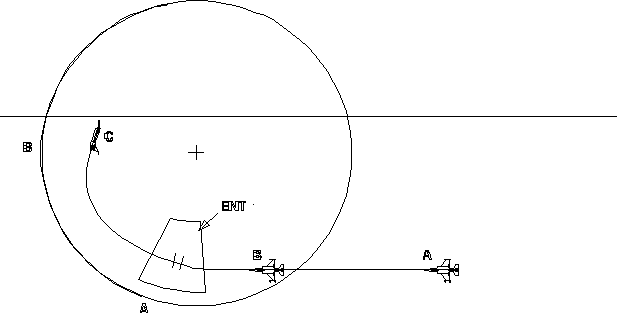
Figure 4.12 Lag to Entry Window
Rate is needed to achieve weapons parameters or defeat attacks. The F-16's turn rate increases very rapidly from slow speed up to 330 KCAS, at which point the rate is the highest (Figure 4.9). Rate allows the attacker to match or exceed the turn rate of his adversary and establish lead for a gunshot. The attacker needs a turn rate advantage that will allow him to pull his nose onto the bandit to employ the AIM-9 or point to lead pursuit for a gun shot. It is important to note an attacker with a higher sustained turn rate can maintain a positional advantage against a defender with a smaller turn radius but reduced rate (Figure 4.13). In order to employ the AIM-9, he must have a turn rate that will allow him to keep his nose within approximately 30° of the bandit for tone acquisition and missile launch. The ability to maintain a high sustained turn rate (corner plateau, 330 - 440 KCAS in the F-16) while the defender sacrifices sustained rate for a tighter turn is another key concept in understanding BFM. In this sense, a turn rate advantage is more tactically significant than a smaller turn radius.
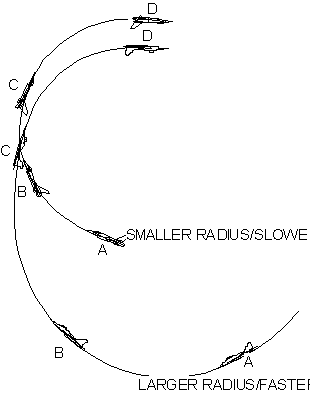
MCM0415
Figure 4.13 Turning at Different Rates
Rate is also used to defeat threats. A defender can use rate to drive an attacker into a lag position and thereby deny him a missile shot or a gunshot opportunity. In close, if the attacker has already established lead, the defender can roll and turn out of the bandit's plane of turn to spoil his gunshot solution. A missile fired in the aft quadrant can be defeated by rotating the aircraft towards 90 ° aspect angle with regard to the missile. This will generate the maximum line-of-sight (LOS) problem for the missile and hopefully exceed its gimbal tracking capability or its turn capability. Slowing below corner to decrease turn radius is not advisable. As already discussed, a smaller turn radius will enhance the overshoot probability of the missile, but the missile will still kill if the overshoot occurs within fuze functioning distance of the target. A higher turn rate, not a small turn radius, is necessary for a successful missile defense. The F-16 also turns better with afterburner (AB). AB gives a better turn capability because it allows the pilot to sustain airspeed and thereby sustain a higher turn rate (assuming near corner velocity).
In addition, maneuvering at higher AOAs results in a greater portion of the aircraft's thrust vector to be pointed toward the center of the turn, which also helps the F-16 maintain a smaller turn radius and greater turn rate. To achieve the highest turn rate possible, slow or accelerate towards corner velocity speed range (330 to 440 KCAS) as quickly as possible and turn hard to generate maximum angles in the shortest time. The maximum LOS problem for a missile occurs at 90 ° of aspect angle (Figure 4.14). For further
discussion on infrared missile defense, refer to MCM 3-1, Volume 5.
It is important to remember that although a turn initiated on the limiter may give you your best initial turn rate, you may not be able to sustain it. Monitor your airspeed. If it falls below 330 KCAS, you will have to relax G (or descend) in order to maintain best sustained turn rate airspeed. Remember, speed is life. Unless you have a reason to be slow, don’t get there.
As a rule of thumb, these are some reasons you may find yourself slow (hopefully not for long) due to trading energy for turn rate:
· Solving those last few angles during BFM in order to employ ordnance.
· To salvage a bad situation. To avoid becoming defensive or losing 3/9 advantage.
· Defeating enemy ordnance.
· You discover you’re a student in the Weapons School.
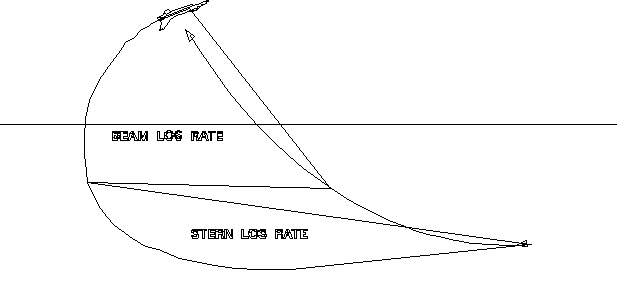
Figure 4.14 Missile LOS Rates
When turning in the vertical, rate and radius are affected by the earth's pull (gravity). Any time the aircraft's lift vector is above the horizon, turn rate is decreased and turn radius is increased. If a loop were performed at a constant (cockpit) G, the flight path would be characterized by an "egg" shape (Figure 4.15). A 4 G loop would result in effective radial G (GR) loading as indicated in the figure. From the cockpit perspective, a 4 G turn at the top of a loop "turns like" a 5 G horizontal turn.
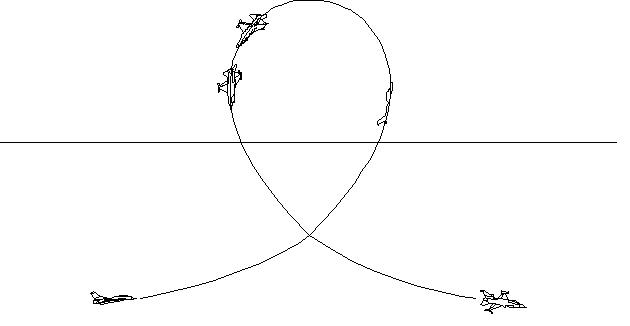
Figure 4.15 Vertical Turning
If a pilot can utilize a downhill turn at key points in a BFM engagement, his relative turning performance will be better than his adversary's. This fact allows an attacker, flying proper BFM and starting from inside the defender's turn circle, to maintain a positional advantage. When a vertical (downhill) turn is used to complete a counter turn, the attacker can more than make up for turn performance lost while performing the counter turn. The attacker can use superior turning performance to solve angle-off problems and choose the desired pursuit curve to fly to weapons employment parameters.
In practice, the counter turn and/or the initial part of the reversal is often accompanied by a slight climb that allows the attacker to set up the downhill part of his maneuver and not be required to fly excessively below the defender's plane of motion while turning to solve angle-off and pursuit curve problems. This slight climb (while turning) and slice turn sequence results in a maneuver commonly called a "Hi Yo-Yo" usually followed by a "Low Yo-Yo." Another important concept of vertical turning is "optimizing" turn rate and energy (airspeed) expenditure. Utilizing maximum available G while entering a purely vertical turn (loop) excessively bleeds energy while "working against" gravity. Generally, a lower G vertical turn is more efficient at the beginning and end of a loop, while maximum G (maximum rate) vertical turns can be best employed when working "with" gravity—from nose pointing straight up until nose pointing straight down. Flying an optimum loop—using 3 - 4 G's at beginning and end, and maximum G available while flying over the top—maximizes vertical maneuvering potential. Maximum turn rate at the bottom of vertical turns should normally be used only to force a trailing aircraft's nose into lag and to cause the trailer to overshoot in the vertical (Figure 4.16). Additionally, vertical turns performed in the "pure" vertical (i.e., no lateral or horizontal component) deny a trailing (similar) aircraft, at a lower energy state, the capability to counter the result of the energy differential by performing an oblique or horizontal turn (Figure 4.17).
![]()
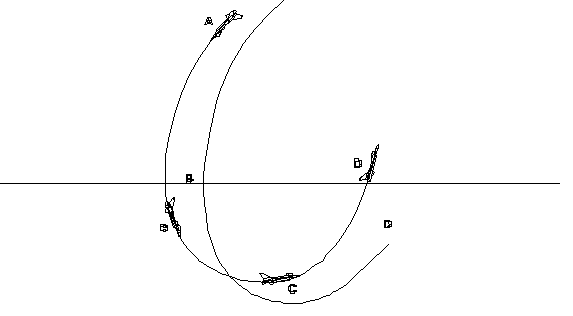
Figure 4.16 Vertical Overshoot
Figure 4.17 Vertical Versus Oblique Turning